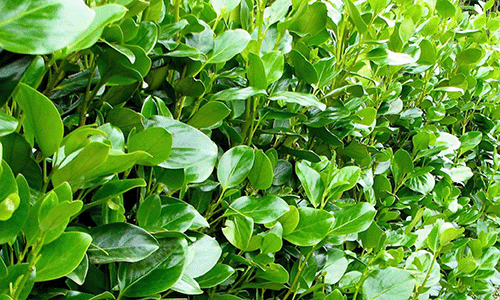By: Marlene Roda | Native Plant Society
Clusia hedges have been popping up all over the area in recent years. People seem to be happy with them, so what’s the problem?
The problem is that we can do so much better!
First, hedges of a single species are always an issue if a pathogen or invasive insect attacks it. Your entire hedge could be gone, leaving you feeling rather exposed. A better decision is to plant a hedgerow of mixed species. They can be grouped by species or by repeating a planting pattern.
Next, the clusia hedges that are being planted are not Florida native plants. Many landscapers think they are native and might even tell you so. They are wrong. They are simply readily available, cheap plants that provide little to no value to our native wildlife.
There is a clusia (Clusia rosea) that is native to Florida, but that one is rarely used in a hedgerow and seldom planted. Most landscapers likely are not familiar with it.
Furthermore, the non-native clusia hedges do not hold up well during hurricanes and are susceptible to breakage. Not only that, but they are generally trimmed with hedge trimmers that cut the thick leaves. It’s not the best look.
Finally, there are too many fabulous native plants that will look better and provide a lot of food and habitat for our native creatures. So, what are they?
Spanish stoppers or Eugenia foetida are fantastic plants that grow very well in sun or part sun. When they bloom, they attract a variety of pollinators. Then, once the blooms turn to berries, birds and other wildlife flock to the shrubs. Best of all, Spanish stoppers are rather slender and generally only grow to 8-10 feet tall. That means they can be minimally trimmed, which saves you money! They are beautiful and they hold up well in hurricanes.
Shiny leaf wild coffee or Psychotria nervosa are great for shadier locations. They grow 4-8 feet tall as they produce flowers for pollinators such as atala, great southern white, Julia and other butterflies. Many other pollinators love them as well. The long-lasting berries are adored by mockingbirds and more.
Peppering in the native firebush or Hamelia patens var. patens could bring hummingbirds and more. Just make sure you get the native firebush that stays much smaller than the “dwarf” that grows to about 18 feet!
Adding a native hedge will provide so much more benefit to the environment over a non-native hedge. The flowers and fruits will bring an assortment of insects and creatures that support the local food chain. There are more options than we have space in this column.
If you are thinking about adding a hedge, ask your landscaper to use Florida native plants and don’t settle for clusia. Consult your local native nurseries for more information or visit The Coccoloba Chapter of the Florida Native Plant Society’s website at www.FNPSCoccoloba.org.








